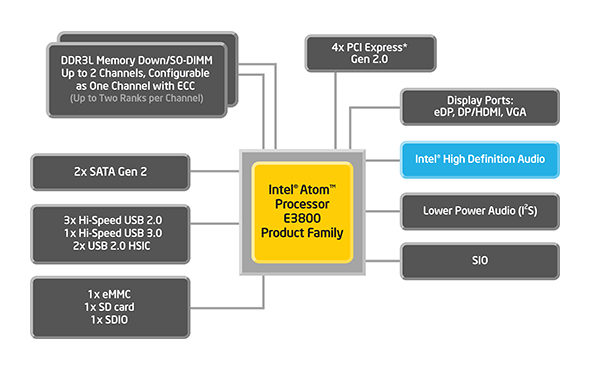
인텔® 아톰™ 프로세서 E3800, 인텔® 셀러론® 프로세서 N2900 및 J1900 제품군(이전 명칭 Bay Trail)
☞ 개요
인텔® 아톰™ 프로세서 E3800 제품군은 지능형 시스템용으로 설계된 최초의 SoC(System-on-Chip)로 폭 넓은 온도 조건에서 작동하며 탁월한 컴퓨팅, 그래픽 및 미디어 성능을 제공합니다. 이 SoC는 Silvermont 마이크로아키텍처를 기반으로, 3D 트라이게이트 트랜지스터를 사용한 22nm 프로세스 기술을 활용함으로써 컴퓨팅 성능과 에너지 효율을 대폭 향상시킵니다.
이 제품군의 주요 특징으로 높은 I/O 연결, 통합 메모리 컨트롤러, 가상화, 오류 정정 코드(ECC)가 있으며 5W ~ 10W의 TDP 범위에서 빌트-인 보안 기능을 제공합니다2. 또한 이 SoC는 효율적인 이미지 작성 워크플로, 보안 컨텐츠를 제공하는 디지털 사이니지, 시각적 효과가 뛰어난 대화형 클라이언트(대화형 키오스크, 지능형 자판기, ATM 및 POS(Point of Sale) 터미널), 휴대용 의료 장비, 산업용 제어 시스템 및 차량 내 인포테인먼트(IVI) 시스템에 적합합니다.
같은 마이크로아키텍처를 기반으로 하는 두 개의 인텔® 셀러론® 프로세서 브랜드 SoC는 인텔의 임베디드 로드맵에서 제공됩니다. 이 SoC는 산업용 온도 범위나 ECC를 제공하지는 못하지만 같은 기능과 와트당 성능의 이점을 대부분 제공하기 때문에 씬 클라이언트, 소매점 거래 클라이언트 및 디지털 서명과 같은 PC와 유사한 설계에 이상적입니다.
프로세서| 프로세서 번호 | 캐시,
클록속도 | 전력 | 메모리 | 제품 기능 및 기술 | 인텔® 아톰™ 프로세서
E3845 | 2MB
1.91GHz | 10W | DDR3L-1333 | 4코어, 542/792MHz 그래픽 주파수(기본/터보), 온도 범위 -40o ~ 110oC, ECC 메모리(선택 사항), 인텔® 고급 암호화 표준 새 명령어, 인텔® 가상화 기술 | 인텔® 아톰™ 프로세서
E3827 | 1MB,
1.75GHz | 8W | DDR3L-1333 | 2코어, 542/792MHz 그래픽 주파수(기본/터보), 온도 범위 -40o ~ 110oC, ECC 메모리(선택 사항), 인텔® 고급 암호화 표준 새 명령어, 인텔® 가상화 기술 | 인텔® 아톰™ 프로세서
E3826 |
1MB
1.46GHz | 7W | DDR3L-1066 | 2코어, 533/667MHz 그래픽 주파수(기본/터보), 온도 범위 -40o ~ 110oC, ECC 메모리(선택 사항), 인텔® 고급 암호화 표준 새 명령어, 인텔® 가상화 기술 | 인텔® 아톰™ 프로세서
E3825 | 1MB
1.33GHz | 6W | DDR3L-1066 | 2코어, 533MHz 그래픽 주파수, 온도 범위 -40o ~ 110oC, ECC 메모리(선택 사항), 인텔® 고급 암호화 표준 새 명령어, 인텔® 가상화 기술 | 인텔® 아톰™ 프로세서
E3815 | 512KB
1.46GHz | 5W | DDR3L-1066 | 1코어, 400MHz 그래픽 주파수, 온도 범위 -40o ~ 110oC, ECC 메모리(선택 사항), 인텔® 고급 암호화 표준 새 명령어, 인텔® 가상화 기술 | 인텔® 셀러론® 프로세서
J1900 | 2MB
2.0GHz | 10W | DDR3L-1333 | 4코어, 688/854MHz 그래픽 주파수(기본/터보), 온도 범위 0o ~ 100oC, 인텔® 고급 암호화 표준 새 명령어, 인텔® 가상화 기술 | 인텔® 셀러론® 프로세서
N2920 | 2MB
1.86GHz | 7.5W | DDR3L-1066 | 4코어, 311/844MHz 그래픽 주파수(기본/터보), 온도 범위 0o ~ 100oC, 인텔® 고급 암호화 표준 새 명령어, 인텔® 가상화 기술 |
☞ Bay Trail-I SoC Series Features
■ Processor Core
• Up to four IA-compatible low power Intel® processor cores
— One thread per core
• Two-wide instruction decode, out of order execution
• On-die, 32 KB 8-way L1 instruction cache and 24 KB 6-way L1 data cache per core
• On-die, 1 MB, 16-way L2 cache, shared per two cores
• 36-bit physical address, 48-bit linear address size support
• Supported C-states: C0, C1, C1E, C6C, C6
• Supports Intel® Virtualization Technology (Intel® VT-x)
■ System Memory Controller
• Supports up to two channels of DDR3L
• 64 bit data bus for each channel
• ECC supported in single channel mode only
• Supports x8 and x16 DDR3L SDRAM device data widths
• Supports DDR3L with 1066 or 1333 MT/s data rates
— Total memory bandwidth supported is 8.5 GB/s (for 1066 MT/s single channel) scalable to 21.3GB/s(for 1333 MT/s dual channel)
• Supports different physical mappings of bank addresses to optimize performance
• Out-of-order request processing to increase performance
• Aggressive power management to reduce power consumption
• Proactive page closing policies to close unused pages
■ Display Controller
• Support 2 DDI ports to enable eDP 1.3, DP 1.1a, DVI, or HDMI 1.4a
• Support 2 panel power sequence for 2 eDP ports
• Support Audio on DP and HDMI
• Supports Intel® Display Power Saving Technology (DPST) 6.0, Panel Self Refresh (PSR) and Display Refresh Rate Switching Technology (DRRS)
• Supports one VGA port
■ Graphics and Media Engine
• Intel's 7th generation (Gen 7) graphics and media encode/decode engine
• VED video decoder in addition to Gen 7 Media decoder
• Supports DX*11, OpenGL 3.0 (OGL 3.0), OpenCL 1.1 (OCL 1.1), OpenGLES 2.0 (OGLES 2.0)
• GPU shader is capable of up to 8 gigaflops
• 4x anti-aliasing
• Full HW acceleration for decode of H.264, MPEG2, MVC, VC-1, VP8, MJPEG
• Full HW acceleration for encode of H.264, MPEG2, MVC
• Supports 2.0 Stereoscopic 3D Stretch
• Polyphase 8 tap scaling
• HD HQV
■ Image Signal Processor
• Support up to three MIPI CSI ports
• Support for up to 24MP sensors
• Supports Stereoscopic Video
■ Power Management
• ACPI 5.0 support
• Processor states: C0-C6
• Display device states: D0, D3
• Graphics device states: D0, D3
• System sleep states: S0, S4, S5
• Dynamic I/O power reductions (disabling sense amps on input buffers, tristating output buffers)
• Conditional memory self-refresh during C2-C6
• Active power-down of display links
• Downloadable power management firmware
■ PCI Express
The SoC has four PCI Express* lanes and up to four PCI Express root ports, each supporting the PCI Express Base specification Rev 2.0 at a maximum of 5 Gbit/s data transfer rates.The root ports configurations are flexible and can be configured to be (4) x1, (2) x2’s, (1) x2 plus (2) x1’s, and (1) x4.
■ SATA
• Two (2) SATA Revision 2.0 ports (eSATA capable)
• Legacy IDE (including IRQ)/Native IDE/AHCI appearance to OS
• Partial/Slumber power management modes with wake
• Capable of 3 Gbit/s transfer rate
• Supports RunTime D3
■ USB xHCI Controller
• Supports USB 3.0/2.0/1.1
• Implements xHCI software host controller interface
• One USB 3.0 Super Speed (SS) port
• Four ports multiplexed with EHCI controller that are High Speed/Full Speed (HS/FS)
• Two High Speed Inter Chip (HSIC) ports compliant with USB 2.0
■ USB 2.0 EHCI Controller
• Internal Rate Matching Hub to support USB 1.1 to 2.0 devices
• Four Ports multiplexed with xHCI controller
• Enhanced EHCI descriptor caching
■ USB 3.0 Device
• Supports one USB 3.0 SS port with USB device compatibility
• Supports one ULPI port with HS/LS support
■ Audio Controllers
Low Power Engine (LPE) Audio
• I2S and DDI with dedicated DMA
• MP3, AAC, AC3/DD+, WMA9, PCM (WAV)
Intel® High Definition Audio (Intel® HD Audio)
• Four in + four out streams (Only 3 used)
• One stream for each DDI, available for HDMI and DP
• No wake on audio (modem) support
■ Storage Control Cluster (eMMC, SDIO, SD)
• Supports one SDIO 3.0 controller
• Supports one eMMC 4.51 controller (B0 stepping, only)
• Supports one eMMC 4.41 controller
• Supports one SDXC controller
■ Intel® Trusted Execution Engine (Intel® TXE)
Intel TXE system contains a security engine and additional hardware security features that enable a secure and robust platform.
Security features include:
• Isolated execution environment for crypto operations (SKU-enabled)
• Supports secure boot - with customer programmable keys to secure code
■ Serial I/O (SIO)
• Controller for external devices via SPI, UART, I2C or PWM
• Each port is multiplexed with general purpose I/O for configurations flexibility
• Supports up to 7 I2C, 2 HSUART, 2 PWM, 1 SPI interface
■ Platform Control Unit (PCU)
The platform controller unit is a collection of HW blocks, including SMBus, UART,debug/boot SPI and Intel legacy block (iLB), that are critical to implement a Windows compatible platform.
Key PCU features include:
• SMBus Host controller - supports SMBus 2.0 specification
• Universal Asynchronous Receiver/Transmitter (UART) with COM1 interface
• A Serial Peripheral Interface (SPI) for Flash only - stores boot FW and system configuration data
• Intel Legacy Block (iLB) supports legacy PC platform features
— RTC, Interrupts, Timers, General Purpose I/Os (GPIO) and Peripheral interface (LPC for TPM) blocks.
■ Package
— 25 mm x 27 mm FCBGA, 1170 solder balls with 0.593 mm (minimum) ball pitch
☞ Platform Brief: Intel® Atom™ Processor E3800 Product Family for Intelligent Systems
|
|





